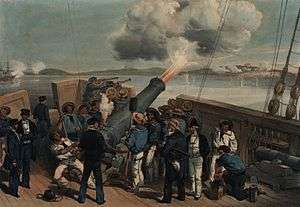Charles Davis Lucas
| Charles Davis Lucas | |
|---|---|
 Bombardment of Bomarsund during the Crimean War | |
| Born |
19 February 1834 Druminargal House, Poyntzpass, County Armagh, Ireland |
| Died |
7 August 1914 (aged 80) Great Culverden, Kent, England |
| Buried at | St Lawrence's Church, Mereworth |
| Allegiance |
|
| Service/branch |
|
| Years of service | 1848–1873 |
| Rank | Rear-admiral |
| Unit | HMS Hecla |
| Commands held | HMS Vixen |
| Battles/wars |
Crimean War Second Anglo-Burmese War |
| Awards |
Victoria Cross Royal Humane Society Lifesaving Medal |
Rear Admiral Charles Davis Lucas VC (19 February 1834 – 7 August 1914) was an Irish recipient of the Victoria Cross. An officer of the Royal Navy, he performed the earliest actions to be recognised with the Victoria Cross, the highest award for gallantry in the face of the enemy that can be awarded to British and Commonwealth forces.[a] He rose to the rank of rear admiral during his time in the navy.
Details
Lucas was born in Druminargal House, Poyntzpass, County Armagh, on 19 February 1834. He enlisted in the Royal Navy in 1848 at age 13, served aboard HMS Vengeance, and saw action in the Second Anglo-Burmese War of 1852–53 aboard the frigate Fox at Rangoon, Pegu, and Dalla. By age 20, he had become a mate.
During the Crimean War, he was awarded the Victoria Cross for the following deed:
On 21 June 1854 in the Baltic, HMS Hecla, with two other ships, was bombarding Bomarsund, a fort in the Åland Islands off Finland. The fire was returned from the fort, and at the height of the action a live shell landed on Hecla's upper deck, with its fuse still hissing. All hands were ordered to fling themselves flat on the deck, but Lucas with great presence of mind ran forward and hurled the shell into the sea, where it exploded with a tremendous roar before it hit the water. Thanks to Lucas's action no one on board was killed or seriously wounded by the shell, and accordingly he was immediately promoted to lieutenant by his commanding officer.[1]
Further information
His act of bravery in Hecla was the first to be rewarded with the Victoria Cross.[a] His later career included service on Calcutta, Powerful, Cressy, Edinburgh, Liffey and Indus.[2][3] He was promoted to commander in 1862 and commanded the experimental armoured gunboat Vixen in 1867.[4] He was promoted to captain in 1867, before retiring on 1 October 1873. He was later promoted to rear-admiral on the retired list in 1885.[2] During his career he received the India General Service Medal with the bar Pegu 1852, the Baltic Medal 1854–55, and the Royal Humane Society Lifesaving Medal.[5]
In 1879 he married Frances Russell Hall, daughter of Admiral William Hutcheon Hall, who had been captain of Hecla in 1854. The couple had three daughters together.[2] Lucas served for a time as Justice of the Peace for both Kent and Argyllshire, and died in Great Culverden, Kent on 7 August 1914. He is buried at St Lawrence Church, Mereworth, Maidstone, Kent.[2]
The medal
Lucas's campaign medals, including his Victoria Cross, are displayed at the National Maritime Museum in Greenwich, London.[5] They are not the original medals, which were left on a train and never recovered. Replacement copies were made, though the reverse of the Victoria Cross copy is uninscribed.[2][5]
Notes
a. ^ The first Victoria Cross recipient to be gazetted was Lieutenant Cecil William Buckley, in the London Gazette of 24 February 1857, for his actions in the Sea of Azov on 28 May 1855.[2] The first recipient to physically receive his award was, because of the seniority of his rank, Commander Henry James Raby, at the inaugural awards ceremony on 26 June 1857. Lucas was fourth in line at the investiture. His were the earliest actions to result in the award of the Victoria Cross.[2]
Citations
- ↑ The London Gazette: no. 21971. p. 654. 24 February 1857. Retrieved 29 March 2015.
- 1 2 3 4 5 6 7 Best, Brian. "Charles Lucas – The First VC". Sample Journal Articles. The Victoria Cross Society. Retrieved 2 June 2011.
- ↑ Wylie, G. Charles Davis Lucas V.C. Poyntzpass and District Local History Society magazine, 2003, issue 9 pages 24–30 Archived October 1, 2011, at the Wayback Machine.
- ↑ "HMS Vixen at William Loney website". Retrieved 2012-04-10.
- 1 2 3 "Victoria Cross (MED2344)". Coins and medals. The National Maritime Museum. Retrieved 2 June 2011.
References
Listed in order of publication year
- The Register of the Victoria Cross (1981, 1988 and 1997)
- Clarke, Brian (1986). The Irish Sword
- Ross, Graham (1995). Scotland's Forgotten Valour
- Doherty, Richard; Truesdale, David (July 2000). Irish Winners of the Victoria Cross. Four Courts Press Ltd. ISBN 978-1-85182-442-7.
- Harvey, David (2000). Monuments to Courage. Naval & Military Press Ltd. ISBN 1-84342-356-1.